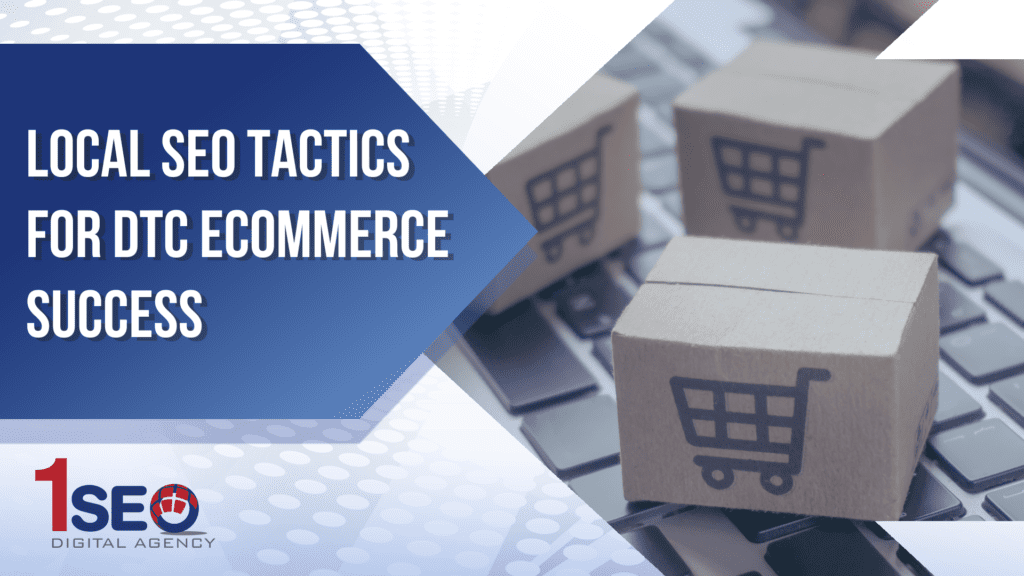Speak To An Expert Now: 215-946-1046
SEO Smarter, Not Harder With Long-Tail Keyword Targeting
If your website tries to perform for highly competitive, broad keywords, showing up in search results can sometimes be a struggle. If you want to

Direct-to-consumer (DTC) ecommerce brands operate in a highly competitive digital landscape where visibility, personalization, and seamless customer experiences are critical to driving growth. While much of ecommerce marketing focuses on broad reach and global scale, local SEO offers a powerful yet often underutilized avenue for capturing regional markets, increasing brand awareness, and boosting conversion rates.
Local SEO isn’t just for brick-and-mortar businesses. For DTC brands that ship nationwide or globally but operate fulfillment centers, host local events, or engage regional influencers, optimizing for local search is essential. As consumers increasingly search for products and services “near me,” DTC brands that align with this behavior can create deeper, more meaningful connections with their audience—whether through search engine results, social media, or localized shopping experiences.
This guide explores how DTC ecommerce brands can implement and scale local SEO strategies to attract the right audience, improve customer engagement, and enhance long-term profitability. From keyword research and content marketing to technical SEO, link building, analytics, and omnichannel integration, we’ll break down the tactics that drive sustainable success in today’s ecommerce ecosystem.
Whether you’re just starting to explore local SEO or looking to refine your strategy for better performance, this in-depth resource provides the insights and direction you need to elevate your brand’s visibility and impact at the local level.

Local SEO helps businesses appear in geographically relevant searches, even for ecommerce brands that operate without traditional storefronts. As the DTC model eliminates intermediaries, brands must take full control of their marketing channels and customer engagement strategies—including appearing on the first page of Google Search when a consumer in a particular region looks for a product.
This is especially useful for DTC brands that use localized fulfillment centers, offer regional shipping benefits, or host influencer events and pop-ups. Appearing in local search results not only increases visibility but also enhances credibility, consumer trust, and brand perception. When customers see your name on a Google Business Profile or a local blog post, they’re more likely to click through, explore your site, and complete a purchase—whether online or through local pick-up options.
To win in local search, your ecommerce platform must first meet the technical requirements of modern search engine optimization. This starts with choosing a relevant domain name that aligns with your brand and product offering. Your URL structure must be clean, keyword-optimized, and support user-friendly navigation. A well-designed website optimized for mobile devices ensures that your content is accessible and functional across platforms—a critical factor as mobile shopping and voice search continue to grow.
Speed, usability, and structured data also play a major role in local SEO. Fast-loading pages enhance user experience and reduce bounce rates, both of which are ranking factors. Use structured data to include information about your business, such as product availability, pricing, and local reviews. This helps search engines understand your content and display rich results, further increasing your click-through rate from the search engine results page (SERP).
Backend elements like XML sitemaps, canonical tags, and faceted search should be optimized to avoid duplicate content and ensure that your entire product catalog is indexed correctly. Implementing inventory management software and product information management systems ensures accurate stock levels and relevant metadata are presented to both consumers and search engines. This infrastructure is especially important in managing omnichannel retail strategies that span across ecommerce and local retail channels.
The foundation of a successful local SEO campaign is keyword research, and for DTC ecommerce, that means focusing on long-tail keywords with geo-specific modifiers. These include phrases like “eco-friendly skincare in Austin” or “buy direct shoes near Toronto.” Using SEO tools like Semrush or Google Search Console can reveal what terms local consumers are searching for—and how your competitors are ranking.
Once you identify high-value keywords, incorporate them naturally into your product descriptions, blog posts, and landing pages. This isn’t just about stuffing keywords; it’s about crafting high-quality content marketing pieces that align with user intent. Storytelling plays a key role here—sharing customer experiences, influencer collaborations, or sustainability initiatives builds engagement and improves your SEO performance at the same time.
Localized content creation can also involve city-specific landing pages, region-focused guides, or community-driven blog posts. Highlighting how your brand participates in the local ecosystem through events, partnerships, or even logistics hubs can differentiate your site in a crowded market. The more relevant your content is to your local target audience, the more likely it is to convert visitors into customers.
Every DTC ecommerce brand with any form of physical presence—be it a showroom, distribution center, or return address—should fully optimize its Google Business Profile (GBP). This is one of the most impactful ways to appear in local map results, the local pack, and even voice search.
Your GBP should include accurate information about your business: address, contact number, hours of operation, categories, and services. High-resolution images, FAQs, links to your online store, and posts about promotions or events further enhance the listing. Consistency is key across all platforms, including business directories, niche marketplaces, and retail partners. This consistency in name, address, and phone number (NAP) data signals credibility to search engines and builds trust with your customer base.
Encourage satisfied customers to leave reviews. Positive feedback enhances your reputation and acts as powerful social proof. Responding to reviews using customer relationship management tools reinforces your commitment to service and improves consumer perception. In combination with automated follow-up emails or loyalty program rewards, review generation becomes an effective loop for customer retention.
Acquiring backlinks from reputable local sources is a cornerstone of any effective local SEO strategy. Reach out to local media outlets, bloggers, influencers, and community platforms to generate buzz and earn high-quality backlinks. These not only drive direct traffic but also improve your domain authority in the eyes of search engines.
DTC brands can also collaborate with local influencers to create authentic, localized content that links back to the website. These partnerships can be centered around product launches, store events, or shared causes like sustainability or community development. As influencer marketing and social commerce continue to expand, these connections offer strong returns in terms of both engagement and organic search traffic.
Competitor analysis also plays a role in backlink strategy. Tools like Semrush can identify where your competitors are getting their backlinks and which local platforms they are using. Understanding the backlink landscape gives you the insights needed to craft a content strategy that targets missed opportunities and leverages your unique selling proposition.
Your product and category pages must not only rank well but also convert visitors into customers. Use schema markup to enhance product listings with reviews, ratings, pricing, and availability. Each product page should include relevant local keywords, customer-centric copy, and optimized images with alt text. Avoid duplicate content by writing unique product descriptions and using canonical tags where necessary.
Ensure your ecommerce site’s navigation is intuitive. A logical architecture improves user experience, helps search engines crawl your site more effectively, and supports conversion rate optimization. Implement faceted search and region-specific filters to allow consumers to sort inventory based on local availability or shipping speeds.
Marketing automation can further personalize this experience. Based on user data and browsing history, your ecommerce platform can recommend locally available products, trigger abandoned cart emails with regional offers, and send loyalty rewards for specific zip codes. These data-driven touchpoints, when executed well, lead to higher customer satisfaction and increased customer lifetime value.
A DTC brand’s local SEO strategy should seamlessly integrate with its broader omnichannel approach. Whether a customer discovers your product on social media, through an influencer’s post, or via targeted advertising, the transition to your ecommerce site or mobile app must be frictionless. This includes localized shipping options, live inventory updates, and tailored messaging that reflects the consumer’s regional context.
Effective supply chain management, including warehouse management systems and logistics coordination, plays a role here. DTC brands that can promise faster local fulfillment or offer same-day pick-up are more likely to convert localized traffic. Clear communication of these logistics benefits on your site and Google Business Profile helps align expectations and builds trust.
Local SEO also supports environmentally friendly practices, a growing concern among consumers. Highlighting sustainable shipping options, eco-conscious packaging, and regional distribution hubs not only improves brand perception but also resonates with audiences that value transparency and ethical manufacturing.
Tracking the success of your local SEO efforts requires robust analytics tools. Google Analytics and Google Search Console provide visibility into organic traffic sources, user behavior, and conversion paths. These insights can inform which content types are resonating with your local audience, which keywords are driving traffic, and where opportunities exist to improve.
Predictive analytics adds another layer of intelligence by forecasting demand based on regional trends, customer behavior, and seasonal patterns. This allows you to pre-stock inventory, trigger marketing campaigns automatically, and fine-tune your advertising spend—all while maximizing gross margin and operational efficiency.
AI-powered tools and automation software can be integrated with CRM systems and ecommerce platforms to streamline your feedback loops, gather insights from customer reviews, and improve touchpoints along the customer journey. The goal is to continuously optimize both your SEO performance and your overall user experience.

With the rise of smartphones and smart speakers, voice search has become a major player in how consumers discover local DTC ecommerce options. Queries like “best natural skincare near me” or “where can I buy sustainable shoes locally” are increasingly made via mobile device or voice assistant. These conversational, long-tail queries require a new approach to keyword optimization.
To align with this shift, DTC brands should create FAQ content targeting voice-activated questions, integrate structured data for local business and product attributes, and prioritize mobile-first web design. Speed, usability, and navigation are critical on mobile platforms, particularly as search engines like Google prioritize mobile usability as a ranking factor. Leveraging local keywords in a natural, spoken tone across your web page content and blog strategy improves your chances of appearing in featured snippets and voice search results.
Voice search optimization also intersects with product discoverability. Incorporating product information management tools and inventory management software helps ensure real-time accuracy, which is essential for satisfying user intent and securing top rankings in hyperlocal and voice-enabled searches.
Artificial intelligence and predictive analytics are transforming how DTC ecommerce brands personalize experiences for their customer base. By analyzing consumer behavior, shopping patterns, and location-specific data, AI can help brands predict what products to promote to specific segments of their target audience.
Predictive personalization allows for dynamic content delivery, such as highlighting locally available products, surfacing early access inventory, or customizing landing pages based on the user’s region. This not only improves the customer experience but also boosts conversion rate optimization by making the shopping journey more relevant and efficient.
Integrating marketing automation and CRM platforms with AI capabilities—such as Klaviyo, HubSpot, or custom-built algorithms—enables brands to trigger localized email marketing campaigns, adjust pricing strategies based on demand, and manage stock distribution across regional warehouses. The result is higher customer satisfaction, better inventory control, and increased customer retention—all supported by a localized SEO framework that ensures your visibility aligns with regional demand.
Social media marketing plays a pivotal role in DTC ecommerce, especially when it comes to fostering community and credibility at a local level. Platforms like Instagram, TikTok, and Facebook allow brands to launch geo-targeted advertising, run influencer campaigns in specific markets, and promote products using localized hashtags and tags.
Social commerce is no longer just a traffic driver—it’s a direct conversion engine. Local influencers can help humanize your brand by demonstrating how products fit into daily life within specific communities. Collaborating with micro-influencers, running region-specific giveaways, and featuring user-generated content from local shoppers all contribute to stronger social proof and SEO value.
Targeted advertising on these platforms can be integrated with local SEO efforts by driving engagement with city-specific landing pages, promotional offers, or in-person events. These campaigns build backlinks, generate buzz, and improve your website’s organic search performance. Influencer-generated content often ranks well in organic search, further supporting your brand’s credibility and link building efforts.
Email marketing remains one of the most profitable marketing channels for DTC ecommerce, especially when personalized and localized effectively. Segmenting your email list by location allows you to send region-specific promotions, notify customers about local fulfillment options, or promote pop-up shops and influencer events in their area.
Platforms like Klaviyo and HubSpot offer advanced automation features that can personalize content based on geographic and behavioral data. For example, a customer in Chicago might receive early access to a new product with free local shipping, while a shopper in Los Angeles could be invited to an exclusive brand event. These tailored messages increase customer engagement and contribute to higher lifetime value.
Email marketing campaigns that emphasize local touchpoints—like product availability, store openings, or regional deals—can also be linked to specific landing pages that are optimized for local SEO. These email-to-page flows support a seamless omnichannel experience and help boost organic traffic when those localized pages are also indexed by search engines.
Structured data, or schema markup, plays a critical role in how your content appears on the search engine results page. For DTC ecommerce brands targeting local visibility, structured data can highlight product details, business information, shipping options, and customer reviews—enhancing the likelihood of earning rich snippets and voice search features.
Adding local business schema to your web pages ensures that Google understands your geographic relevance. This is especially important for DTC brands with multiple distribution centers or serviceable regions. Marking up your product catalog with pricing, availability, and location-specific fulfillment details improves your content’s visibility in organic search.
From a technical SEO perspective, you should also audit your site regularly for duplicate content, crawl errors, and site speed issues. Tools like Semrush and Google Search Console can identify performance gaps, help optimize your site for long tail keywords, and boost your local SEO framework. A robust backend supported by inventory management, warehouse management systems, and content management solutions ensures your SEO efforts scale efficiently.
Sustainability is more than a buzzword—it’s a growing expectation among today’s consumers, particularly in North America and Europe. DTC ecommerce brands that emphasize environmentally friendly logistics, local sourcing, and sustainable shipping practices gain a competitive advantage not only in customer perception but also in local search rankings.
Search engines are increasingly prioritizing brands that demonstrate transparency, social proof, and long-term commitment to ethical practices. Creating content that highlights your brand’s sustainability initiatives—such as using recycled packaging, sourcing materials locally, or reducing emissions through regional distribution—can improve your relevance for eco-conscious keywords and drive meaningful engagement.
Integrating these messages into your content marketing strategy strengthens brand loyalty and improves retention. It also gives you valuable material for email marketing, influencer campaigns, and community partnerships—all of which feed back into your SEO performance and conversion optimization efforts.
Building brand loyalty at a local level fosters strong community relationships and encourages repeat purchases. Loyalty programs that reward customers for engaging with region-specific offers, referring friends locally, or attending in-person events increase brand stickiness and enhance your customer journey.
Use your CRM and analytics tools to identify top customers in each region and offer exclusive deals, early access, or branded merchandise. These localized touchpoints can be promoted through automated email workflows, SMS marketing, or even direct mail for an omnichannel approach.
Incorporating loyalty program content into your local landing pages improves organic traffic and provides keyword-rich content that search engines can index. Mentioning local influencers who’ve joined the program, showcasing regional testimonials, and linking to related blog posts further enhance backlink potential and on-page SEO value.

DTC ecommerce success relies on more than great products—it requires a cohesive digital strategy that bridges local visibility with global scalability. For ecommerce businesses ready to elevate their local SEO game and dominate their niche markets, 1SEO Digital Agency is the partner of choice. With years of experience helping ecommerce brands thrive, our team delivers data-driven, performance-focused digital marketing solutions tailored to your unique business model.
At 1SEO, we don’t just implement tactics—we build sustainable, long-term strategies that integrate seamlessly with your existing operations and technology stack. Our expertise spans every critical touchpoint in your customer journey, ensuring that your brand ranks higher, engages smarter, and converts better.
Our most relevant services for DTC ecommerce brands include:
Whether you’re looking to enhance your brand’s visibility in local search, improve customer experience through personalization, or streamline your marketing channels, 1SEO has the tools, talent, and proven strategies to deliver results. Let’s work together to build a smarter, stronger, and more profitable ecommerce business—locally and beyond.
If your website tries to perform for highly competitive, broad keywords, showing up in search results can sometimes be a struggle. If you want to

In today’s world, networking is essential to business growth. Building relationships with the right people can open the door to amazing opportunities that will take